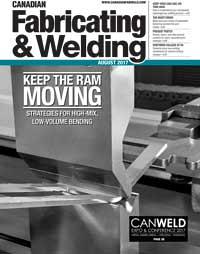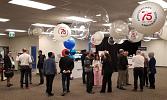Director of Sales, Metal Processing
- FMA
- The Fabricator
- FABTECH
- Canadian Metalworking
The Right Finish
Automated deburring machines come in many configurations. Make sure you get the right system for your needs
- By Tim Corley
- August 23, 2017
- Article
- Fabricating
Deburring solutions vary depending on what type of technology you use to cut materials and what quality of finish you require on finished parts. Earlier this spring, Lissmac and 3M Abrasives teamed up for a two-day seminar at the 3M facility in St. Paul, Minn., to address key deburring bottlenecks and the machines available for deburring, edge rounding, oxide removal, deslagging, and surface finishing. 3M technicians were on hand to lend their expertise on abrasive media such as grinding belts and barrel brushes. Twenty customers attended the event and brought with them the challenges they face in the deburring area.
On the second day, customers brought their own sample parts to run on the machines being demonstrated at the event, the Lissmac SBM L G1S2 1500 and Lissmac SMW 543. These two automated deburring machines are designed to meet the most common deburring needs of today’s shops.
The key takeaway for attendees was that while there are many automated deburring options available, it’s important to choose equipment that is properly designed for the fabricating processes of a shop currently and in the future.
Basic Deburring – Laser and Punched Parts
The SBM L G1S2 1500 model is designed to deburr and edge round the top and bottom of CO2 and fibre laser cut parts, and punched parts. The first head, G, is designed for grinding off a vertical burr. There are two grinding belts in the first head, one on top and one on bottom. The grinding belts remove any vertical burr that could have been produced with a laser or punch. The second head is the S, which stands for sand block belts. The sand block is made of multiple layers of an abrasive strip. A nonwoven material backing between the abrasive strips gives it rigidity and helps round the edge of the part.
We have heard from many customers that fibre laser cutting, especially when working with stainless steel, can leave a tough burr or dross, and that the cut edge is sharp. The G1S2 combination of grinding belts and sand block belts removes the burr and leaves a safe, rounded edge.
Surface Finish Finesse
The second machine, SMW 5 Series, demonstrated deburring and surface finishing/graining on one side of a part. Four heads give the machine the ability to deburr, edge break, and provide an aesthetic surface finish. The first head and last head have roller drums that use a wide, abrasive belt. The grit varies depending on the application. The second head has a top brush, which can be equipped with ceramic, steel, or combi-style brushes that spin and oscillate side to side to remove any secondary burrs and provide edge break. The third head had a 3M Scotch Brite™ barrel brush for that can be equipped with a variety of brush styles to grain or satinize the finish on the part.
Many companies have older machines that have one abrasive wide belt. Deburring and finishing has evolved so much that the one-head abrasive belt is not really sufficient for the finishes customers demand. Today’s deburring and edge break specs have changed, making it necessary to have at least one abrasive belt head and one barrel brush or top brush to effectively remove burrs. It is also better to have two to three heads for finishing. The SMW 5 series has a control that allows operators to select the heads needed depending on the application.
There are many factors we look at when determining the best machine configuration for an application. Are your parts produced on a laser or punch? If produced on a laser, how hard is the vertical burr? If the burr is hard and needs to be removed, we suggest removing it with a 65 durometer drum with an 80-grit belt. The second head could be a 35 durometer roller drum. The 35 durometer has a softer rubber coating and with the appropriate flexible belt (120-grit) will help remove a secondary burr and deburr interior and perimeter edges. A Scotch Brite barrel brush is recommended for the third and fourth heads. The barrel brushes help satinize the surface finish and, with the oscillation, help break and soften the edges. With our SMW 5 series the rotation on the barrel brushes can be clockwise or counter-clockwise, which helps clean the leading and trailing edges of the part.
If you run a small job shop on a limited budget, a two-head SMW 123 wet machine is recommended. It can be purchased with one abrasive belt head that is always in the first position. The second head could use a top brush for deburring or a barrel brush for finishing. With a larger budget, the SMW 5 series with four heads allows the operator to turn off any of the heads not needed for an application.
Custom Solutions
The customers at the seminar came from a variety of industries, each with its own specific demands. Some were from small job shops, automotive suppliers, OEMs, steel service centres, and large contract manufacturers. Many companies still hand grind to deburr parts, which in many cases creates a bottleneck. It also means that deburring is subjective to each person grinding the parts. What is acceptable to one person is not acceptable to others; that can create a quality issue downstream or, even worse, at the customer’s facility. Having a machine process the parts takes that subjectivity out of the equation. The parts will come off the machine uniformly deburred, grained, deslagged, edge-rounded, and with the oxide removed.
Getting better paint adhesion on steel parts was a problem mentioned by many customers during the seminar. Research through the years has shown that edge rounding and oxide removal will improve paint adhesion. Individual machines for edge rounding and oxide removal are available, as well as combination machines that offer both processes. The combination machine (S2B2 1500) combines the technology of the edge rounding S2 sand blocks and the B2 oxide removal brushes into one machine for edge rounding and oxide removal on the top and bottom in one pass. This combination of processes provides superior results in a salt spray test for paint adhesion.
Some attendees from steel service centres asked about deslagging thick parts that had been cut with a plasma or oxy-fuel torch. They currently have workers manually chipping off slag and then grinding the edges. Lissmac has two machines that work in tandem to remove this kind of slag – the D2 1500 and the G2S2 1500. The D2 is equipped with two belts on top and two on the bottom. The belts have power pins attached that chip off the slag. Once the slag is chipped off, the parts are then conveyed to the G2S2 1500, which has two abrasive grinding belts located on the top and bottom of the machine to grind the part, and two sand block edge rounding belts on the top and bottom to finish and slightly round the edge. Shops often use motorized conveyors before, between, and after the machines to allow the parts to be conveyed between machines safely.
Automated deburring machines can save a shop time and money and remove the stress of repetitive work from the hands of skilled employees. Make sure that the system you consider matches all the needs of your shop’s part mix.
Tim Corley is director of sales – metal processing, for Lissmac Corp., 518-326-9094, www.lissmac-usa.com.About the Author
subscribe now


Keep up to date with the latest news, events, and technology for all things metal from our pair of monthly magazines written specifically for Canadian manufacturers!
Start Your Free Subscription- Industry Events
MME Saskatoon
- May 28, 2024
- Saskatoon, SK Canada
CME's Health & Safety Symposium for Manufacturers
- May 29, 2024
- Mississauga, ON Canada
DiPaolo Machine Tools Open House 2024
- June 4 - 5, 2024
- Mississauga, ON Canada
FABTECH Canada
- June 11 - 13, 2024
- Toronto, ON Canada
Zoller Open House & Technology Days 2024
- June 12 - 13, 2024
- Ann Arbor, MI























